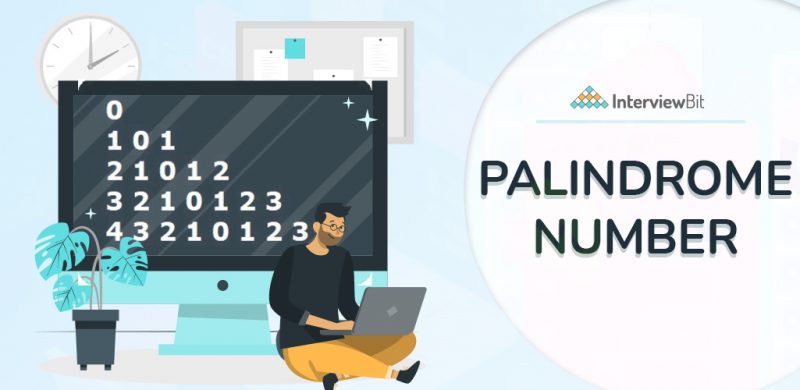A palindrome number is a number that remains the same when digits are reversed.
For example, the number 12321 is a palindrome number, but 1451 is not a palindrome number.
Problem Statement
Given a positive integer, the task is to check whether the number is palindrome or not.
Confused about your next job?
Example:
- Input: 1221
- Output: True
- Input: 146541
- Output: False
- Input: 5
- Output: True
The idea is to make a number with all the digits of the given number present in reverse order and check if both numbers are equal. Follow the below steps to solve the problem.
- First, Declare a variable reverseNum and initialize it with 0.
- Now, make a while loop till the original number is greater than zero.
- In every loop get the last digit of the number and add that digit at the end of the reverseNum and then, divide the original number by 10.
reverseNum = reverseNum * 10 + (number % 10)
- Lastly, check if the original number and reverseNum number are equal or not.
Dry run of the above approach
- Orginal = 1221
- reverseNum = 0
- tempOrginal = 1221
| Iteration 1 | lastDigit = 1 reverseNum = 0 * 10 + 1 = 1 tempOriginal = 122 |
| Iteration 2 | lastDigit = 2 reverseNum = 1 * 10 + 2 = 12 tempOriginal = 12 |
| Iteration 3 | lastDigit = 2 reverseNum = 12 * 10 + 2 = 122 tempOriginal = 1 |
| Iteration 4 | lastDigit = 1 reverseNum = 122 * 10 + 1 = 1221 tempOriginal = 0 |
reverseNum = original
Implementation
C/C++ Implementation
bool checkPalindrome(int original) {
int reverseNum = 0;
int tempOriginal = original;
while (tempOriginal > 0) {
int lastDigit = tempOriginal % 10;
reverseNum = reverseNum * 10 + lastDigit;
tempOriginal = tempOriginal / 10;
}
if (original == reverseNum) {
return true;
} else {
return false;
}
}Java Implementation
public int checkPalindrome(int original) {
int reverseNum = 0;
int tempOriginal = original;
while (tempOriginal > 0) {
int lastDigit = tempOriginal % 10;
reverseNum = reverseNum * 10 + lastDigit;
tempOriginal = tempOriginal / 10;
}
if (original == reverseNum) {
return 1;
} else {
return 0;
}
}Python Implementation
def checkPalindrome(original):
reverseNum = 0
tempOriginal = original
while (tempOriginal > 0):
lastDigit = tempOriginal % 10
reverseNum = reverseNum * 10 + lastDigit
tempOriginal = tempOriginal / 10
if (original == reverseNum):
return 1
else:
return 0- Time complexity: O(log10(N)), Where N is the given number.
- Space complexity: O(1)
Special Case
The above solution will only work if the number is less than 1018, but what would happen if the number is greater than 1018?
Implementation
C Implementation of Special Case
bool checkPalindrome(char original[]) {
int n = sizeof(original) / sizeof(original[0]);
for (int i = 0; i < n / 2; i++) {
if (original[i] != original[n - 1 - i]) {
return false;
}
}
return true;
}C++ Implementation of Special Case
bool checkPalindrome(string original) {
int n = original.size();
for (int i = 0; i < n / 2; i++) {
if (original[i] != original[n - 1 - i]) {
return false;
}
}
return true;
}Java Implementation of Special Case
public boolean checkPalindrome(String original) {
int n = original.length();
for (int i = 0; i < n / 2; i++) {
if (original.charAt(i) != original.charAt(n - 1 - i)) {
return false;
}
}
return true;
}Python Implementation of Special Case
def checkPalindrome(original):
n = len(original)
for i in range(0, n//2):
if original[i] != original[n - i - 1]:
return False
return True- Time complexity: O(L), Where L is the length of the given string.
- Space complexity: O(1)
Practice Question
Frequently Asked Questions
Q.1: Can a negative number be palindrome?
Ans: No, negative numbers can not be palindromes.
Q.2: Can we solve this problem without converting an integer to a string?
Ans: Yes but only for integers less than 1018.
Q.3: Are all single-digit numbers palindrome?
Ans: Yes
Q.4: How is the time complexity of the above algorithm O(log10(N))?
Ans: Because we are dividing the input number N by 10 in every iteration. So, there is going to be a total of log10(N) iterations.




